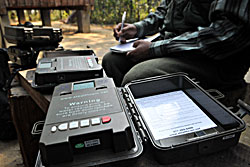 PICS: NANDA RANA |
The nationwide tiger census will be completed in March, but with half of Chitwan National Park covered so far, 20 adults and 12 cubs have been counted. The number of breeding tigers is expected to top 60, which was the total number from the previous census in 2000.
"The situation doesn't appear to be as bad as it was thought," says a beaming Narendraman Babu Pradhan, chief warden at Chitwan.
The census is being carried out with 50 sets of digital cameras that are placed along jungle trails and triggered by movement. The images are analysed and individual tigers identified by their distinctive stripes. Forty staff on five elephants are involved.
 |
The camera trapping technique is also being used in two western reserves in Bardiya and Sukla Phanta where tigers were decimated by Indian poachers in the past eight years. The army was withdrawn from jungle posts during the war, allowing armed poachers free movement.
In Sukla Phanta, tiger numbers dropped from 20 in 2005 to eight last year; however, preliminary results of the census show that the majestic cats are springing back there too.
Says Naresh Subedi of the National Trust for Nature Conservation, which is carrying out the census with the Department of National Parks and Wildlife: "We will have to wait for the final tally, but so far we are all pleasantly surprised at least in Chitwan that tigers aren't as badly affected as we had feared."
In 2000, there were 123 breeding tigers and about 200 cubs in national parks all over Nepal. A further 100 tigers probably live in wilderness areas that aren't designated national parks. That number has probably gone down, but conservationists expect the total tiger tally in parks to be about the same as in 2000.
Smile, you're on candid camera
 |
Near a watering hole, technicians alight from elephants to fix the digital cameras on the side of trails frequented by tigers. The elephants are getting nervous and blow noisily through their trunks.
The ongoing nationwide tiger census has so far covered half the Chitwan National Park and 20 tigers and 12 cubs have been identified by their distinctive stripes. The other half of the park in the Chure Hills and the Madi Valley beyond has a significantly larger number of tigers, so the census-takers are optimistic that tiger numbers are rebounding.
However, in Bardiya and Sukla Phanta the tiger numbers were down by 30-50 percent between 2005 and 2008 and are recovering at a slower pace. "It appears that poaching was much more widespread in western Nepal," says Naresh Subedi of the National Trust for Nature Conservation (NTNC).
This is the first scientific tiger census in Nepal using digital camera trapping technology. It is combined with a count of pug marks and scratches on trees to confirm the number of tigers. "The stripes of individual tigers are as distinct as our finger prints, and the count can be pretty exact," explains Subedi.
Until the 1950s when the forest cover in the Tarai was still intact, tiger ranged from Mechi to Mahakali. Since the eradication of malaria during the 1960s, transmigration of hill people to the Tarai meant that prime habitats for wildlife were cleared for settlement and agriculture. Nowadays, tigers are found only between the Bagmati and Mahakali rivers in the Tarai.
Poaching, habitat loss and the depletion of prey have contributed to the steady loss of the species. In India, tiger populations are down to 1,100 from 2,000 fifteen years ago. The Sariska reserve in Rajasthan has lost all its tigers to poaching in the past ten years.
In Nepal, national parks were relatively better protected by the army as well as effective buffer zone mobilisation of villagers for conservation and anti-poaching intelligence. "We have put the army back into the abandoned posts, and poaching is now under control," says Laxmi Manandhar at the Department of National Parks and Wildlife Conservation in Kathmandu, "and we see the happy result in the Chitwan tiger census."
However, the chief warden of Chitwan National Park, Narendraman Babu Pradhan, says much more could be done if the conservation sector had more resources to mobilize people in buffer zones, increase mobility of rangers and upgrade research.
ENUMERATOR
 |
"We have to always keep our eyes and ears open here," whispers Lama, "we could run into rhinos, bears or tigers." With 30 years of experience as a naturalist, Lama knows instinctively from the wildlife calls whether there is danger near. He hasn't had any confrontations during this census, but wild elephants have smashed cameras in Bardiya after they flashed at night, and bears sometimes play with them and wreck the aim.
The digital cameras are positioned on both sides of tiger trails, facing each other and at a distance of 1.5 to 2 km for 15 days at a time. They are triggered by wildlife movements, and besides tigers they have also "shot" wild boar, bears, leopards and lots of deer. Lama's team sets 50 cameras every two weeks in a section of the park, gathers all the images for analysis and moves on to the next area.
What makes Lama really happy is when his camera snaps portraits of tigresses with their cubs


